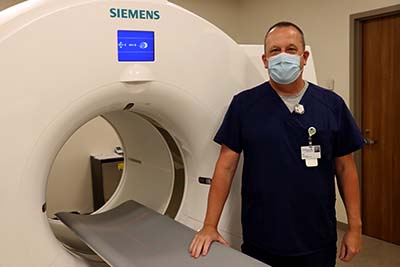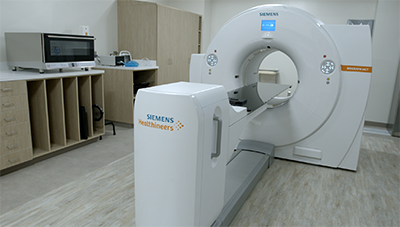What to expect during a PET scan
Cancer
St. Joseph’s/Candler and the Lewis Cancer & Research Pavilion offer PET imaging in Savannah and Bluffton
If your doctor suspects you may have cancer or wants to look closer at a suspicious nodule, he or she may recommend a PET scan. This safe, advanced imaging modality can cut scan time for patients and radiation exposure in half, leaving physicians with high-quality images that can detect cancer cells the size of a pencil tip.
Positron emission tomography, also called PET scanning, is a simple and non-invasive diagnostic radiology procedure. It’s a type of nuclear medicine imaging that uses small amounts of radioactive material for early detection of illnesses, most often cancer.
At the Nancy N. and J.C. Lewis Cancer & Research Pavilion, we offer PET scanning at both our Savannah and Bluffton campuses, having the only PET imaging machine in the Bluffton area.
If you’ve ever had a CT or MRI scan, you may find some similarities, mostly the fact that you are lying in a tubal machine to produce images inside your body. However, there are some key differences you should be aware of if your doctor orders a PET or PET-CT scan.

“A lot of people when they walk in the door, they’ve had CTs and they are used to getting a quick injection and go in the scanner for 10 minutes or so and they are done,” says Bill Feagley, PET-CT technologist at the St. Joseph’s/Candler – Bluffton Campus. “But here at PET scanning, it takes a little longer. It’s about an hour and a half to two hours.”
What to expect
Upon arriving to your appointment, a technician will ask about your medical history, including recent surgeries, biopsies, injuries or previous PET scans. He or she also will explain the process thoroughly and address any questions you may have.
“I try to put myself in their shoes because a lot of people are scared of cancer,” Feagley says. “A lot of people when they come to a cancer center think they have cancer. That’s not always the case. We’re here to help them find out if they do or don’t. If they do, PET can help find it early. It will detect stuff the size of a pencil head, super small.”
Then, using a tiny needle, you will receive an injection of a radioactive sugar-water like substance. Because you are asked not to eat or drink anything except water after midnight, your body should be craving sugar. Cancer cells have higher metabolism rates than healthy cells because they are trying to grow and spread, Feagley explains, so those cells will soak up the sugar-like substance first.
After you’ve allowed the medicine to filter through your body, which is usually 45 minutes to an hour, it’s time for the scan. Depending on your height and weight, most scans take 18 to 20 minutes, Feagley says.
Also, your doctor may order a PET-CT. Our machines are equipped with the capability of producing images from both modalities, which results in fused imaging, allowing doctors to see special views. If this is the case, you will first go through the CT portion of the machine, followed by the PET scan.
Related Article: What do expect during a CT scan

Today’s machines are larger and faster than before, Feagley says. You will lay flat on a board, with a warm blanket if you like, and slowly move out of the circular tube. Most PET scans start at the base of your skull and about every two minutes move down in sections typically finishing at the mid-thigh. If your doctor suspects skin cancer, then a full-body scan may be necessary.
Because your head is at the back of the machine, within minutes it will be outside the scanner, which is helpful if you are claustrophobic, Feagley says. Also, Feagley likes to talk to patients during the scanning process – that is, unless they are asleep.
“There’s a humming sound, but otherwise it’s really quiet in there. Most people fall asleep.”
Results
The images produced through a PET or PET-CT scan are the highest quality they’ve ever been. They reveal organs, bones, muscle, tissue, even blood flow, Feagley says. If cancer cells are detected, they are usually brightly lit and more intense on the image.
Most patients understandably want their results right away. While Feagley has been a PET-CT technician for a number of years, it’s the radiologist’s job to read the results and share with your referring physician.
Rules
There are guidelines you need to follow both before and after your PET scan including:
- No food or liquid (except water) after midnight the day of your scan.
- Belt buckles, jewelry, hearing aids, cell phones and other such items will need to be removed before the scan; pacemakers and ports are OK.
- It’s OK to take certain medications before your scan, but be sure to talk to your doctor about those medications, especially if it’s for diabetes.
- You can drive a vehicle after the scan. If you are so claustrophobic you need a sedative, such as Valium, you should have a driver with you.
- For at least six hours following your scan, avoid close contact with small children and babies. After about six hours, most of the medicine has left your body by drinking water and going to the bathroom.
- Avoid breastfeeding for 24 hours; the milk can’t harm the baby if you wish to pump, but you should avoid that close contact with babies.